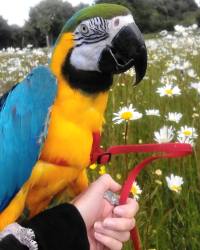
Do you take your birds outside? I like to roll my bird’s cage outside and let him get fresh air and enjoy the sunshine. He also likes to get sprayed from the hose and fly around in his flight cage. Good times!!
Taking your pet birds outside during the warm weather months can be a wonderful experience for your birds, or it can be a terrifying & traumatic experience! It all depends on your bird and its personality and phobias, as well as the method you choose for the outdoor experience.
Exposure to natural sunlight (full spectrum) is important to the long-term health of parrots. Like humans, vitamin D from the sun is essential to good health. Recent studies show that sunlight through glass windows has reduced full spectrum so it can be very beneficial for them to have exposure to direct light. However, your bird’s physical safety and emotional well being must always come first. If your bird is phobic when taken outside, then, by all means, do not force them.
Please! Never take your bird outside without some kind of restraint – either in a cage, a carrier, or harness! Even with clipped wings, many birds can still become airborne if the right breeze comes along to provide the necessary lift.
Using A Bird Harness: Some birds are willing to accept a harness which allows your bird to flay their wings as they ride on your arm or shoulder. It does, however, have its drawbacks. First of all, many birds just plain won’t accept a harness and it’s too stressful to try to force them. But if you are a lucky person with a bird that will accept the harness, you still must be very careful. A sudden noise, such as a car driving by, a horn honking, or even the sight of a dog, cat, or wild bird (like a hawk!) might frighten your bird and cause them to fly off of your shoulder in fear. Although they are on a leash and can’t fly away, if you are not paying attention, your bird could land hard on the ground and be injured, or you could even accidentally step on them.
Check the condition of the harness regularly, because many birds can snip through the nylon cording very quickly and suddenly fly away.
Never use your birds’ harness as a tether to a t-stand or other perch. Your bird is defenseless when tethered and could become easy food for a hawk or even a crow. Also, if they fly off of the perch in fear, they could become entangled in the harness or hit the ground hard.
When your bird is out on a harness, don’t forget to keep track of the time and how long it has been since your bird had access to food or water. While your bird may come to enjoy your walks while in a harness, it is still an exciting and stressful activity, so make sure they get plenty of rest after an outing and don’t make it an all-day event unless you have gradually worked up to longer hikes. Don’t get overconfident just because your bird is on a harness and leash — there are still many dangers to consider.
Outside Cages And Carriers: This is my preferred method. The birds are safely contained, but they are also protected from predators and have access to food and water at all times. I have small cages for my birds — usually just big enough for the bird to stretch out their wings. For instance, the cockatiel and conure are in 12″ x 12″ square cages; the cockatoo and Eclectus go outside in 24: wide travel cages (I call these their “porch cages”.) Each porch cage has one perch, and a food and water dish. There’s no need for toys as they are not in them all day long.
Location of Outside Time: Avoid putting the birds in direct sunlight — they can become overheated very quickly. But also be aware of the temperature and that the shade is much cooler than where you are probably sitting. I like the dappled shade on my deck under my big maple tree in the late afternoon — it provides the right mix of sun and shade.
Getting Started: It’s important to start slowly when taking them outside and to be very aware of their natural fears when outside. Put the porch cage against a wall outside, and cover the top and sides with a towel, leaving only the front end open for the birds to look out. Stay with them the entire time, talking calmly to them. make the first session no more than 5 or 10 minutes, then take the bird and came back inside.
Each time they go out in their porch cages, you can work on increasing the time. You can also gradually fold back the towel so that half of the top and sides are open — but make sure to leave the back half of the cage and part of the sides and part of the top covered with the towel! This towel provides a shelter for them to hide behind if they see a wild bird that frightens them, or if the sun comes through too much and they need the shade.
After a while, your birds will be very comfortable with all side of the cage open. However, make sure to still put a small towel over half of the top of the porch cage so they have an area of retreat from sun or perceived predators.
The really fun thing about outside time in their cages is how they come to enjoy it. On especially warm summer days, after about 30 minutes outside, they are absolutely thrilled to get their showers — all of them have wings fully spread out, every feather on their bodies raised to all the water to penetrate to their skin. Several of my birds will actually hang upside down so I can get them soaked all the way through!

If the air is really warm, your birds might also enjoy being sprayed with a soft cold water spray from the garden hose. Make sure that you are far enough away that the water spray is not hard and aim the hose above the birds so the waterfalls on them like natural rain. Also, there is some concern that bacteria may breed in garden hoses, so drain your hoses after every use and run water through the hoses for several minutes before aiming the water at your bids.
MAKE SURE ALL CAGE DOORS LOCK SECURELY! so they can’t get out. Never leave your birds alone while outside in the porch cages — use their outside time as your excuse to sit down alongside them, and make time to read that magazine or book!
**adapted from Linda Roberts**
1,989 total views, 1 views today
